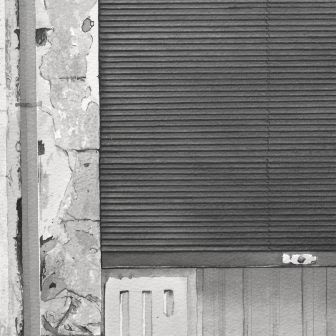
Épicerie
Thomas Schürmann, 2016, Aquarell,
Schmincke Horadam, Rives Arches Grain Torchon,
Size: 100 cm x 46 cm
The picture, painted in February 2016, shows the closed grocery store in the Avenue du Puy in Pradelles as a large-format black-and-white watercolour in charcoal grey. Pradelles is located north of the river Allier in the French département of Haute-Loire en région Auvergne-Rhône-Alpes.
Épicerie
A vendre
Robert Louis Stevenson would probably have walked past this grocery store if it had existed about 150 years ago. In 2014, the German-French television station Arte showed a series on beautiful hiking trails in Europe in its evening program. On one of the evenings, the Stephenson Trail in the French Cevennes was presented.
The last time I walked a distance of more than 200 km was in 1999 and I had never walked alone before, but I was pretty quick on fire, which may have been due to the fact that the presenter and author of the episodes - Bradley Mayhew - has a charismatic way of introducing people, landscape and route.
After some planning I walked the 220 km long Stephenson Trail from Le Puy-en-Velay in the north to St-Jean-du-Gard in the south in early autumn 2015. Robert Louis Stevenson, the author of Treasure Island and The Strange Case of Dr. Jekyll and Mr. Hyde, hiked this way in 1878 at the age of twenty-eight with a donkey - acquired in Le Puy - to learn something about the landscape and the history of Protestant persecution in this area. He wrote down his travel experiences in the book Travels with a Donkey in the Cévennes (1879), which is well worth reading.
The Trail leads from a very green north to the typical Mediterranean landscape of the southern mountains of France through a scenery that changes from sap to blue-green. A green, extensive landscape of great distance, lined by faded ego's of formerly living villages, which makes at the same time very sad, but for me as an artist visually very interesting.
On the basis of this journey, ideas for a total of 5 completed paintings have been developed in le Puy-en-Velay, Pradelles, Le Monastier-sur-Gazeille and Langogne.
I have tried in different ways to give space in two dimensions to this decay on paper, this destruction through the unstoppable course of time and the social and economic change. Looking at it, one can see that human work and lively urban culture can only be preserved and revived through continuous economic activity. Otherwise, shop facades, applied lacquers, woods and wallpaper, curtains and drapes will be replaced in the course of time by the nothingness that everyone - mostly young people - fear. The watercolour painting embalms this decay in a lasting snapshot.
The watercolour painting
The watercolour is 105 cm x 46 cm and painted on Rives Arches Grain Torchon paper with Horadam charcoal grey make-up. In contrast to the other motifs in this series, it has a less closed and freer border, which makes the motif appear less delimited and opens to all sides.
Detail illustrations
The pictures underneath show the depth and detail of the watercolour. Unfortunately, the digitizations shown here can only give an idea of the depth and breadth of the picture.
Balcony above the Allier
Pradelles
The oldest mention of Pradelles dates back to January 965. 1054 years ago (from 2019) this small village, situated on a hill north of the river Allier, was first mentioned on a map. The village is dominated by the large statue of the Virgin Mary on Notre Dames de Pradelles. On the Stephenson Way you reach the place from the north and it proves to be a true architectural manifestation of Stephenson's novel title, as it is half ugly and half beautiful and handsome, like Jekyll and Hyde. There is still a grocery store and the Brasserie du Musée is a good place to stay and dine.
Trivia
The village of Pradelles is surrounded by a network of underground tunnels that lead from the heart of the village to several places beyond the historical enclosure. It allowed the villagers to leave the village in the Middle Ages without the knowledge of the attackers. Unfortunately, most of them collapsed or the entrances were deliberately blocked for security reasons.
(Source: Wikipedia)


